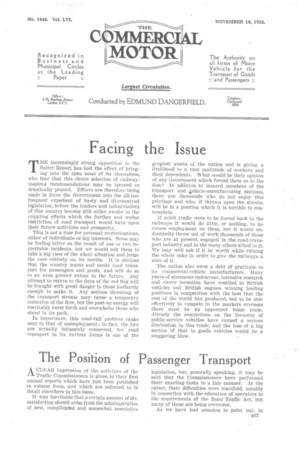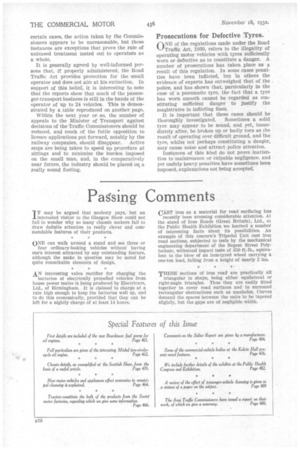The Position of Passenger Transport
Page 43

Page 44

If you've noticed an error in this article please click here to report it so we can fix it.
ACLEAR impression of the 'activities of the Traffic Commissioners is given in their first annual reports which have just been published in volume form, and which are referred to in detail elsewhere in this issue.
It was inevitable that a certain amount of dissatisfaction should arise from the administration of new, complicattd and somewhat restrictive legislation, but, generally speaking, it may be said that the Commissioners have performed their exacting tasks in a fair manner. At the otitset, their difficulties were manifold, notably in connection with the education of operators to the requirements of the Road Traffic Act, but many of these are being overcome.
As we have had occasion to point out, in B17 certain cases, the action taken by the Commissioners appears to be unreasonable, but these instances are exceptions that prove the rule of unbiased treatment meted out to operators as a whole.
It is generally agreed by well-informed persons that, if properly administered, the Road Traffic Act provides protection for the small operator and does not aim at his extinction. In support of this belief, it is interesting to note that the reports show that much of the passenger-transport business is still in the hands of the operator of up to 24 vehicles. This is demonstrated by a table reproduced on another page.
Within the next year or so, the number of appeals to the Minister of Transport against decisions of the Traffic Commissioners should be reduced, and much of the futile opposition to licence applications put forward, notably by the railway companies, should disappear. Active steps are being taken to speed up procedure at sittings and to minimize the burden imposed on the small man, and, in the comparatively near future, the industry should be placed on a really sound footing.
Prosecutions for Defective Tyres.
ONE of the regulations made under the Road Traffic Act, 1930, refers to the illegality of operating motor vehicles with tyres sufficiently worn or defective as to constitute a danger. A number of prosecutions has taken place as a result of this regulation. In some cases penalties have been inflicted, but In others the evidence of experts has outweighed that of the police, and has shown that, particularly in the case of a pneumatic tyre, the fact that a tyre has worn smooth cannot be regarded as constituting sufficient danger to justify the magistrates in inflicting fines.
It is important that these cases should be thoroughly investigated. Sometimes a solid tyre may appear to be sound, and yet, immediately after, be broken up or badly torn as the result of operating over difficult ground, and he tyre, whilst not perhaps constituting a danger, may cause noise and attract police attention.
Instances of this kind do not prove inattention to maintenance or Culpable negligence, and yet unduly heavy penalties have sometimes been imposed, explanations not being accepted.




















































































































